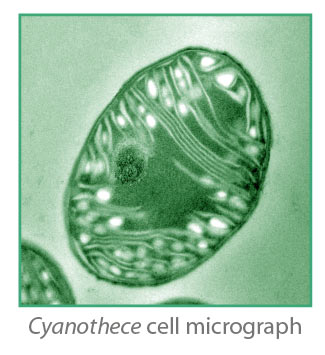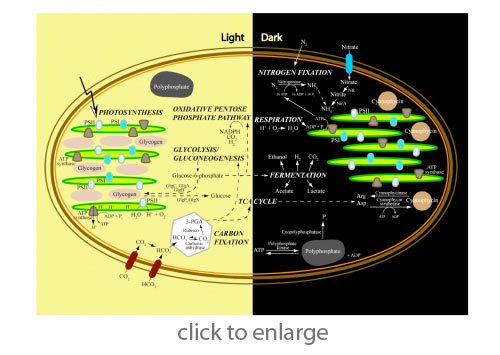B. Why Study Cyanobacteria?
Cyanobacteria are oxygen producing photosynthetic microbes present in numerous ecological niches on the Earth and consume carbon dioxide as part of their natural metabolic process. Accordingly, they provide a potentially powerful biological solution for carbon-neutral energy production and carbon sequestration. The genome of Cyanothece, a marine cyanobacterium that executes two separate and incompatible mechanisms of nitrogen fixation in dark and photosynthesis in light, has only recently been sequenced and annotated as part of the EMSL Membrane Biology Grand Challenge project. Many cyanobacteria prevent O2-mediated damage by compartmentalizing nitrogen fixation and photosynthesis in separate and specialized cells, physically isolating the nitrogenase apparatus, which is very sensitive to O2, a key product of photosynthesis. In contrast, Cyanothece separates nitrogen fixation and photosynthesis temporally in each cell—having to switch its molecular machinery twice daily to accommodate this separation. The presence or absence of light, in part, triggers a cascade of gene synthesis, protein translation, intercellular signaling, and shifts in membrane organization that lead to the functional changeover from photosynthesis to nitrogen fixation, and vice-versa. In tandem with these processes are a host of other time-dependent processes, which the cell switches based on its internal mechanisms as if anticipating the light/dark cycle, rather than reacting to it. This combination of reacting to and anticipating the light-dark cycle is rooted in the genetics of Cyanothece, but results in macroscopic changes in the cell—buildup or degradation of energy storage granules, for instance. The link between sensing light, sensing time of day, gene control, membrane organization, protein content, and signaling points to a very complex interplay of physical, chemical, and biological processes which act in concert to enhance the efficiency and hence the likelihood of survival and proliferation of Cyanothece in its natural environment. An understanding of these mechanistic processes in an integrated systems context should provide insights into how Cyanothece might be optimized for specialized environments and/or industrial purposes. Engineering Cyanothece as a viable large-scale component of carbon sequestration or renewable energy production will require detailed understanding of its energy production and cell cycling processes at the systems level.


